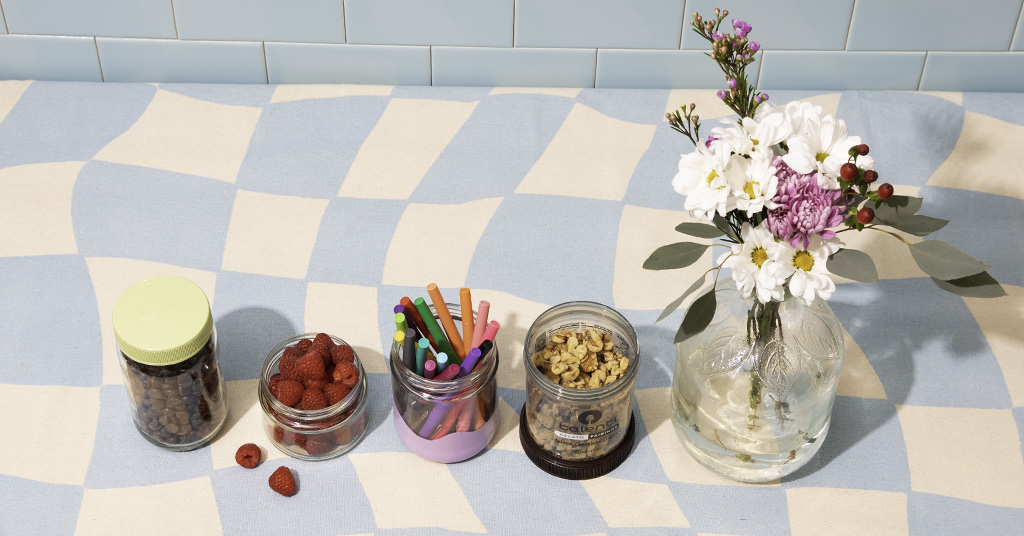In today’s world, there is a growing trend towards repurposing and upcycling, as people seek creative ways to give new life to old items. Upcycling is the process of transforming waste materials into new and useful items. Here are some creative ways to upcycle and repurpose some of your common household items.
Reuse Glass Jars for Leftovers & Supplies
Rather than throwing away glass jars after they’re empty, consider washing and reusing them as containers for leftover food. Glass jars are particularly useful for storing items such as soups, stews, salsas, and sauces. They can also be used as a snack container for nuts, granola, or pretzels. Not only are they a great way to reduce waste, but they also help to keep your fridge organized and make it easy to see what you have on hand.
Some glass containers are perfect for keeping other household items such as pencils or pens. If the jar is large enough and has a nice design, use it to showcase a beautiful bouquet of flowers.
To upcycle a glass jar, use or dispose all of its contents and wash thoroughly with soap and water. Relabel the jar by removing the product label and adding your own to properly organize it in your fridge.
Upcycle Empty Plastic Containers
Similar to glass jars, empty plastic containers also have a great use case for storing leftovers and household supplies. Empty deli meat containers work perfectly as a Tupperware to store leftovers and hold your lunch. They can also be used as an organizer for small items such as craft and office supplies.
Plastic coffee containers with tight-fitting lids are perfect for disposing of cooking grease. Rather than pouring grease down the drain, which can cause clogs and damage to pipes, pour it into a coffee container and store it until it can be thrown away.

Make Your Own Chicken Bone Broth
If you’ve ever bought one of our rotisserie chickens, you may have been left with a pile of bones after enjoying your meal. Rather than throwing the bones away, consider using them to make your own chicken stock. Use it as a base for soups, stews, and other dishes.
Chicken Bone Broth Recipe
Ingredients:
- Leftover bones from a rotisserie chicken
- 1 onion, chopped
- 2-3 carrots, chopped
- 2-3 celery stalks, chopped
- 3-4 cloves garlic, smashed
- 1-2 bay leaves
- 1 tablespoon black peppercorns
- Water
Instructions:
- Begin by removing any meat that’s still on the bones and setting it aside for another use. You can also leave some of the smaller pieces of meat on the bones if you prefer.
- Place the bones in a large pot or Dutch oven and add enough water to cover them by about an inch or two.
- Add the chopped onion, carrots, celery, garlic, bay leaves, and black peppercorns to the pot.
- Bring the water to a boil over high heat, then reduce the heat to low and let the broth simmer for at least 4-6 hours, or even up to 24 hours for a richer broth.
- As the broth simmers, skim off any foam or scum that rises to the surface with a spoon.
- After the broth has simmered for the desired amount of time, strain it through a fine-mesh strainer into a clean container. You can discard the bones and vegetables, as they will have given all of their flavor to the broth.
- Let the broth cool to room temperature, then cover and refrigerate it overnight. This will allow any fat to rise to the surface and solidify, making it easier to skim off.
- The next day, skim off any solidified fat from the surface of the broth and discard it.
- Use the broth immediately or store it in the refrigerator or freezer until needed.

Start your own composting bin
Composting is a great way to repurpose organic waste such as fruit and vegetable scraps, coffee grounds, and eggshells. By composting, you can reduce your household waste and create nutrient-rich soil for your garden or houseplants.
To start composting at home, you have a few options for your compost bin. You can either buy a pre-made compost bin or you can make your own using a plastic container. Whatever option you choose, make sure that your bin has a lid and ventilation to allow for proper airflow. Now you can add any of your food scraps to your new compost bin!
These eco-friendly practices not only benefit the planet but can also be a fun and creative way to give new life to old items. So, start looking around your home and see how you can upcycle and repurpose your common household items today!
